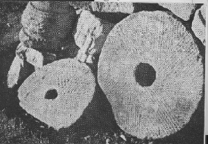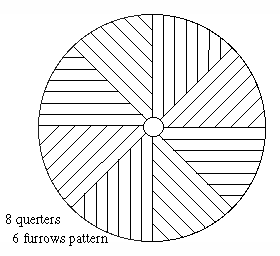 Reynolds,J."Windmills
& Water mills"(Hugh Evelyn London,1970)p13
Reynolds,J."Windmills
& Water mills"(Hugh Evelyn London,1970)p13Link:
The stone mill was a product of large Cultural Exchange between East and West
During my study of stone mill, I found large alternating current
of civilization between west and east. It was first stage of my study. When
I had begun to be interested in a stone mill, a photograph of a stone mill of
Britain Roman Empire period was same to the 8 querters.
 Reynolds,J."Windmills
& Water mills"(Hugh Evelyn London,1970)p13
Reynolds,J."Windmills
& Water mills"(Hugh Evelyn London,1970)p13
 Typical
Japanese pattern of stone mill surface in Japan
Typical
Japanese pattern of stone mill surface in Japan
Why same? Just, It is my start of study for mills. This is not accident. It
was an entrance to an unknown magnificent history of civilization. Hedin, Sven
Anders (1865-1952) (http://www.infoplease.com/ce6/people/A0823182.html) or (http://www.kirjasto.sci.fi/shedin.htm)
reported in his writing ,that there was a stone mill more than a diameter of
1m on the Silk Road, and there was the stone mill rotating by waterpower. At
the starting point of the Silk Road confirmed a stone mill of , Chinese Tunhuang
museum , which was 8 quater. DUNHUANG ( http://www.textile-art.com/dun1.html)
 A
old stone mill displayed the museum (there is a very possibility BC‚Q‚P‚O)
A
old stone mill displayed the museum (there is a very possibility BC‚Q‚P‚O)
I upset it, and the moment that confirmed the drawing for wonderful eight 8
querters. In that moment an official woman in charge found that, and controlled
cry that "don't move that". I can not got the phonograph of the under
side. More unfortunately there was not interest to that, and about the source
was a general private house. They have no information for the importance of
the stone mill. There were similar remains by Mr.Yonezawa in a museum neighborhood,
but says that it was lost by public work.
This was a form of the ancient times different from a stone
mill used until recently in China each place recently. We cannot even imagine,
the time many temple managed prospered. ( Japanese old document, Auther Naha(1941).
The stone mill which used until recently which I am about to often look at in
China (I discovered it by the roadside to Mausoleum of the First Bin Emperor).
Comparison of the rice civilization and the wheat civilization
The rotary cuern that appeared for several centuries in orient before B.C. several
century possessed nature worth of technical superiority for expelled a quern
of dominately linear motion, saddle cuern before it. It is because there was
on the basis of rotary motion. In particular, in civilization with much depending
on wheat like Europe, rotary cuern did a basis of the wheat flour milling, and
it was the leading role of an industrial civilization establishment process
of the West. Here, it is important to think about diffence of the processing
of rice and wheat. The paddy from a ear of a rice plant are covered with a hard
chaff. To remove the chaff we can eat. I hull the all and can process it with
a mortar, and there is not a process to grind. For the the process we can use
We hull it more and polish rice wi th a mortar, and, as for the rice, it is
polished rice with unpolished rice if I thresh it. However, there is not it
hard skin eats wheat deeply in an albumen part and is crowded, and I begin to
take this, and to separate if I want to crush it finely.
Fig. rice preparation process in Japan e_riceprep
In the processes from grain to a human mouth, there are no fine grinding process.
The labor for the ancients to eat wheat extorted more labor in comparison with
rice diet. People of the Ancient Orient invented, a quern (a stone mill) in
labor to be necessary for it and let they are develop. And it was Egyptian civilization
that let you jumboize saddle khan to an extremity. Because it turned rotary
motion into a basis, the rotary khan that appeared on the development line was
tied to power of a waterwheel and a windmill and was able to open up a road
to industrialization of a flour milling process later.
A water wheel flour milling factory: K.Marx(1818-1883) writes in the work "Das
Kapital that "the Roman Empire had handed down the elementary form of all
machinery in water-wheel. " Almost all Japanese water-wheel under standed
is as same as Japanese drawing by Indian ink.
Return